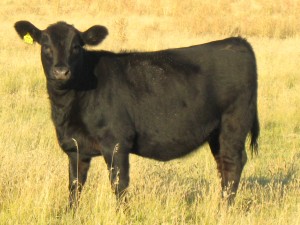THE question

In my travels throughout the northern plains states and western U.S. I am often asked by producers; “How do I produce CAB?”.
First, one must understand the specifications of the Certified Angus Beef® brand, which have been covered here in detail previously. Then, it’s important to understand that there is no certification process for live animals, so a ranch cannot consign the cattle or commit them to the brand prior to harvest.
Over 85% of the U.S. packing plant capacity is licensed to produce the brand, so most fed cattle will find their way through the proper channels to be considered for qualification into the CAB® brand. The real chore for the individual producer is not finding a market niche, it’s simply to build the quality (internal quality, as in “carcass quality”) within the cow herd and then marketing that quality to an advantage.
I think that producing quality carcass genetics is an often misunderstood concept, one that’s ridiculed by some as a “fad” or a “chase” toward a single trait, with dire consequences. Admittedly, there have been times when the cattle business has seen fads, when we’ve taken what seemed like a good thing way too far. The easy example to highlight is the vast difference in mature frame size of the 1950’s versus the 1980’s. The word “extreme” hardly describes those contrasts.
At Certified Angus Beef, we don’t think in terms of chasing after marbling, the most influential of the 10 carcass specifications. We think in terms of getting the best out of Angus cattle.
That’s exactly what I tell people. If you have Angus cattle, you’ve got the foundation for success in terms of carcass quality. After all, the “Butcher’s Breed” is not an accidental nickname. So, there’s an accurate assumption that with Angus cattle we’re starting with more than average potential to generate enough marbling to hit the specs for the CAB® brand. But it’s just potential unless you add focus. Clearly, a balance of economically important traits is the key to selection, but keeping positive pressure on marbling is relatively easy to do. I can find high and low birth-weight bulls with marbling as well as high and low growth bulls with marbling, so why not go with marbling? After that, genetic selection within the breed for cattle that are, at the very least, above breed average for the marbling EPD will get you moving toward the goal.

Then, it’s on to management and marketing, which I’ll cover in another segment. So check back tomorrow to get the rest of the story…
~Paul
You may also like
Nebraska Ranch Receives Certified Angus Beef Commercial Award
Troy Anderson, managing a Nebraska ranch, focuses on breeding thriving maternal cows that will grade premium Choice and Prime, while respecting livestock, people and land. Anderson Cattle receives the 2023 CAB Commitment to Excellence Award. Their journey includes improving genetics, feeding home-raised and purchased calves and using data for better breeding decisions, all with a bottom-line approach.
Everything They Have
Progress is a necessity on the Guide Rock, Nebraska, ranch where Troy Anderson manages a commercial Angus herd, small grower yard, his 10-year-old son, and a testing environment. Troy’s approach includes respect for his livestock, people and land. For that, Anderson Cattle was honored with the CAB 2023 Commercial Commitment to Excellence Award.
Progress, Not Perfection
It’s a labor of love, obvious in the way she lights up explaining their family’s 33-year effort to proactively adapt Angus cows to their land. A lifetime of telling stories from the pasture or kitchen has resonated with nonfarm consumers as much as fellow ranchers. “Everything we do is about cattle, but it’s also about family and connecting our kids to the land and to the cattle,” Debbie Lyons-Blythe says.



